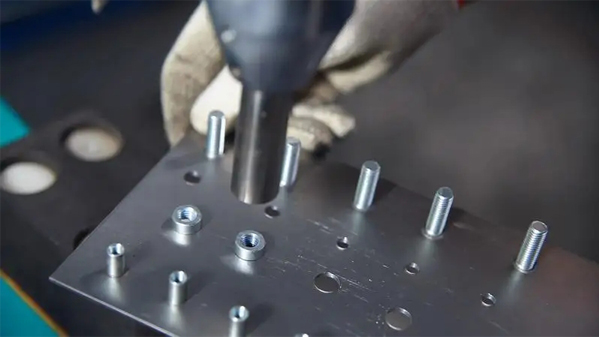Riveting is a commonly used joining process that involves fixing rivets to two or more workpieces to tightly connect them together. Riveting has advantages such as strong structure, corrosion resistance, and high temperature resistance, and is widely used in aviation, automotive, construction, and other fields. The following will provide a detailed introduction to the riveting process.
1. Preparation work
A series of preparatory work needs to be done before riveting. Firstly, it is necessary to select suitable rivets and riveting pliers. The selection of rivets should be based on the material of the workpiece. The thickness and requirements are determined, and the selection of riveting pliers should be based on the specifications and usage environment of the rivet. Secondly, it is necessary to perform surface treatment on the workpiece to be riveted, ensuring a smooth and free from oil and rust. Finally, other auxiliary tools such as drilling machines, polishing machines, etc. should be prepared.
.jpg)
2. Drilling
Before riveting, it is necessary to drill holes on the workpiece. The position and diameter of the drilling hole should be determined according to the requirements of the rivet. When drilling, attention should be paid to maintaining the verticality of the hole and the flatness of the hole bottom. After drilling, it is necessary to use a grinder to polish the hole opening to remove burrs and rust and ensure smooth insertion of rivets
3. Rivet insertion
Before inserting the rivet, it is necessary to place one end of the rivet into the jaws of the rivet pliers. Then, insert the other end into the drilling hole to make it tightly fit with the workpiece. During the insertion process, maintain a certain insertion speed and force to avoid being too fast or too slow.
.png)
4. Rivet fixation
After the rivet insertion is completed, it is necessary to fix the rivet. This step usually requires the use of riveting pliers to complete. Riveting pliers are generally divided into two types: manual riveting pliers and pneumatic riveting pliers. When using riveting pliers, it is necessary to place both ends of the riveting pliers on both sides of the rivet and then press it firmly. During the compression process, it is necessary to maintain uniform force to ensure that the contact surface between the rivet and the workpiece is tightly fitted.

5. Check and adjust
After riveting is completed, inspection and adjustment are required. Firstly, check the fixing condition of the rivet to ensure that it fully fits the contact surface with the workpiece. Secondly, it is necessary to check the firmness of the riveting points to ensure that there is no obvious looseness or deformation of the riveting points. If any problems are found, they need to be adjusted or replaced in a timely manner.

6. Cleaning and maintenance
After riveting is completed, it is necessary to clean and maintain the tools and work area. Firstly, clean the oil and debris on the rivets and riveting pliers to ensure their normal use. Secondly, it is necessary to clean up the clutter and garbage in the work area to maintain a clean working environment. Finally, it is necessary to maintain the riveting pliers and other tools, such as lubrication and periodic maintenance, to extend their service life.
The riveting process can be simply summarized as preparation work, drilling, rivet insertion, rivet fixation, inspection and adjustment, cleaning and maintenance, and other steps. By strictly following these steps for riveting, the quality and reliability of riveting can be ensured. The application range of riveting technology is wide, and mastering the riveting process is of great significance for improving work efficiency and product quality.
